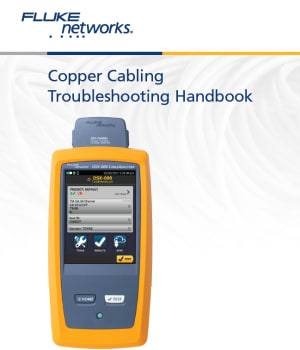Cable Network Certification Made Easy – when you go by the book
Follow articleHow do you feel about this article? Help us to provide better content for you.
Thank you! Your feedback has been received.
There was a problem submitting your feedback, please try again later.
What do you think of this article?
Fluke Networks have published a new Copper Cabling Troubleshooting handbook designed to help Datacom cable installation professionals to use their new release DSX-600 CableAnalyzer™ to certify their copper cabling systems quickly and efficiently.
Why is Certification Important?
As the guide explains, “certification is the process of comparing the transmission performance of an installed cabling system to a standard, based on a defined method of measuring the performance”. Not only does obtaining certification clearly demonstrate the quality of components and installation, it’s also usually needed to obtain a warranty from the manufacturer.
But as many Datacom cabling installation engineers will know, without the right tools and expertise certifying or troubleshooting installations can be time-consuming and troublesome. As Fluke Networks point out in the handbook introduction, over recent years newer high-performance copper cabling installations have required higher levels of skill and thoroughness, leading to a need for tools that can provide more sophisticated levels of diagnosis. The objective of the new handbook is to familiarise copper cabling installation testers with the DSX-600’s functions, the nature of typical faults and how the device’s diagnostics report them so that they can reduce the time they take to correct a fault or a defective component – quicker certification, less downtime.
The handbook walks installers step-by-step through the troubleshooting of advanced cable systems using the DSX-600 – making them more productive and helping them to pass certification faster.
Autotesting Functionality
The guide starts by introducing one the DSX-600’s most useful functions – “autotest” – explaining how it speeds up certification testing across different link models. As stated in the handbook, before testing starts, it is vital that users select the correct test standard – this determines the link model (Permanent Link or Channel), the correct parameters to be measured, frequency range over which testing will be carried out and Pass/Fail criteria.
Significantly, the handbook also contains a simple check-list for testers to ensure that they have got all the basics in place before they start testing, helping them to avoid wasted time and effort.
Automated Diagnostics
The handbook moves on to talk in some detail about the DSX-600’s automated diagnostics functionality, explaining how the device can be set up to find the cause of marginal passes or failures, and how it can identify the specific causes of wire map failure.
In summary, in the case of a marginal test result (pass or fail), the DSX-600 can be set up to perform advanced HDTDR and HDTDX tests to obtain information to help identify what may have caused the marginal result. If the cabling link fails to pass the wire map test, the guide also goes on to explain how users can run a scan to identify intermittent connection, with a further option to delay fixing until they have moved on to test more links.
Advanced Troubleshooting Section – Common Causes of faults
After describing how to carry out Shield Integrity Testing, the guide goes into more detailed advice to explain advanced techniques for diagnosing link failures, presenting cases when automated diagnostics may fall short and focussing in on HDTDR (High Definition Time Domain Reflectometry) and HDTDX (High Definition Time Domain Crosstalk) parameter diagnosis. For each parameter, the guide talks users step-by-step through specific failures and how to carry out detailed graph analysis to identify potential causes.
Finally, the handbook includes a table which offers testers a quick view of troubleshooting tips to help them identify the cause of failures for each of the required TIA and ISO structured cabling measurements – including suggested reasons why the measurement does not fail in some cases where users would expect to see a failure.
Want to find out more? To order your printed copy of the Fluke Networks Copper Cabling Troubleshooting handbook, click on the link below:
Banner link – to purchase the Fluke Networks DSX-600 CableAnalyzer™, click here
Learn More About Fluke Networks
The worldwide leader in certification, troubleshooting, and installation tools for professionals who install and maintain critical network cabling infrastructure, Fluke Networks help network professionals to ensure the performance and reliability their installations.
Already a trusted supplier for Datacom contractors, Enterprise datacenters and networking departments and Communications service technicians for more than 25 years, from installing the most advanced data centres to restoring telephone service after a disaster, the company's combination of legendary reliability and unmatched performance ensure jobs are done efficiently.
Fluke Networks main product categories are:
- Copper and Fiber Certification testers from our Versiv family: DSX-5000, OptiFiber Pro, CertiFiber Pro, FI-7000
- LinkWare Live Software as a Service
- Copper Qualification & Verification testers: MicroScanner, CableIQ
- Fiber Qualification & Verification testers: SimpliFiber, Fiber Inspection and Cleaning
- Tools for Telecom Test Technicians: Butt sets, Hand Tools
To see the full Fluke Networks range available from RS, click here




